当前位置:网站首页>8. C language - bit operator and displacement operator
8. C language - bit operator and displacement operator
2022-07-06 13:26:00 【It's Wang Jiujiu】
This paper adopts 《C Primer Plus》、《C Traps and defects 》 And the teaching video of bit technology .
Yes C Language bit operators and displacement operators are explained in detail , To impress , Each knowledge point has examples and practical explanations
Catalog
1. Press ( Binary system ) Bit and &
2. Press ( Binary system ) Bit or |
3. Press ( Binary system ) Bit exclusive or ^
4. Press ( Binary system ) Bit inversion :~
3. Off bit ( Clear the vacancy )
1. Use the displacement operator to convert integers into binary form
2. After converting a value n position
Bit operators
1. Press ( Binary system ) Bit and &
The rules : The corresponding bits are 1 when , The result is 1, Otherwise 0.
for example :
int a = 1,b = 3;
00000000 00000000 00000000 00000001 //a
00000000 00000000 00000000 00000011 //b
00000000 00000000 00000000 00000001 //a&b=1
When the value is stored in the computer , Are stored in the form of complement , Positive integer ( Include 0) The original code of 、 Inverse code 、 The complement is the same ; And the original code of negative numbers 、 Inverse code 、 The complement needs to be calculated : By inverting the original code and adding 1, You can get the complement of an integer ; Similarly, add a complement inversely 1, You can also get the original code of this number .
#include<stdio.h>
int main()
{
int a = 1;
int b = 3;
int c = a & b;
printf("a=%d,b=%d,c=%d\n", a, b,c);
return 0;
}
2. Press ( Binary system ) Bit or |
The rules : As long as one of the corresponding bits is 1, The results for 1, Otherwise 0.
for example :
int a = 1,b = 3;
00000000 00000000 00000000 00000001 //a
00000000 00000000 00000000 00000011 //b
00000000 00000000 00000000 00000011 //a|b=3
#include<stdio.h>
int main()
{
int a = 1;
int b = 3;
int c = a | b;
printf("a=%d,b=%d,c=%d\n", a, b,c);
return 0;
}
3. Press ( Binary system ) Bit exclusive or ^
The rules : Only one corresponding bit is 1, The result is 1, Otherwise 0.
for example :
int a = 1,b = 3;
00000000 00000000 00000000 00000001 //a
00000000 00000000 00000000 00000011 //b
00000000 00000000 00000000 00000010 //a^b=2
#include<stdio.h>
int main()
{
int a = 1;
int b = 3;
int c = a ^ b;
printf("a=%d,b=%d,c=%d\n", a, b,c);
return 0;
}
practice : Use the XOR operator to exchange the values of two variables ( No extra variables are created )
#include<stdio.h>
int main()
{
int a = 1;
int b = 3;
printf("a=%d,b=%d\n", a, b);
a = a ^ b;//2
printf("1:a=%d,b=%d\n", a, b);
b = a ^ b;//1
printf("2:a=%d,b=%d\n", a, b);
a = a ^ b;//3
printf("3:a=%d,b=%d\n", a, b);
return 0;
}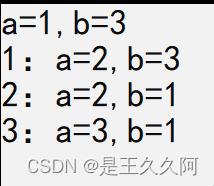
4. Press ( Binary system ) Bit inversion :~
hypothesis a The type is int,a To be an assignment 1;
a:
Original code :00000000 00000000 00000000 00000001
Inverse code :00000000 00000000 00000000 00000001
Complement code :00000000 00000000 00000000 00000001
Reverse it by bit , Turned out to be 0 The place becomes 1, Turned out to be 1 The place becomes 0, Then after taking the opposite, it becomes :
~a:
Complement code :11111111 11111111 11111111 11111110
Inverse code :10000000 00000000 00000000 00000001 // The sign bits remain the same , Other bits are reversed
Original code :10000000 00000000 00000000 00000010 // Inverse code +1,~a = -2
#include<stdio.h>
int main()
{
int a = 1;
int b = ~a;
printf("a=%d b=%d \n", a,b);
return 0;
}
notes : The bit operation itself does not change the value of the variable , Instead, create a new value , If you want to change the value of a variable, you can use :&=、|=、^=、~=.
Bit operator usage
1. Mask
Bitwise and operators are often used with masks (mask). The so-called mask refers to some set to on (1) Or off (0) Bit combination of .
Define a symbolic constant MASK by 2, The form of the next eight bits in memory is 00000010, This MASK Scale mask .
Define another variable a, The assignment is 7, The form of the next eight bits in memory is 00000111.
#include<stdio.h>
#define MASK 2
int main()
{
int a = 7;
a &= MASK;
printf("a=%d\n", a);//a=2
return 0;
}a&MASK = 00000010, On the far right is 0 No. A , Leftmost 7 No. A . In the process of bitwise AND , except 1 Number one 1 Shows , All remaining bits are displayed as 0. This process is called “ Use a mask ”, Because in the mask 0 Hidden variables a The corresponding bit in . Here are the common uses of bitwise AND :
a &= 0xff;
// perhaps
a &= 0377;0xff by 16 Base number , Its binary form is 11111111, The octal form is 0377. This mask will hold variables a The last eight digits in the remain unchanged , The other bits are set to 0. No matter what a How many people are there , The final values are modified to 1 individual 8 Bit byte ,8 Is the width of the mask .
2. Open bit ( Set bit )
Sometimes it is necessary to open a specific position in a value , While keeping the other bits unchanged . for example : To turn on the built-in speakers , Must open 1 No. A , While keeping the other bits unchanged , In this case, you can use bitwise OR operator (|).
Set a variable a and MASK( Only position one is 1) For example :
hypothesis a by 00000111,MASK by 00000010, that a |= MASK =00000111.
MASK In Chinese, it means 1 Bit ,a Also in 1;MASK In Chinese, it means 0 Bit ,a Keep the same in .
If you want to open it at the same time 1、3、5 No. A , Then you can put MASK Set to :00101010, Set according to different needs MASK.
3. Off bit ( Clear the vacancy )
Similar to the open bit , Sometimes it is also necessary to turn off finger positioning without affecting other bits . Suppose you want to close the variable a Medium 1 No. A , You can do this :
Define symbolic constants MASK Only 1 The number is 1:00000010
#include<stdio.h>
#define MASK 2
int main()
{
int a = 6;
printf(" Before change :%d\n", a);
a &= ~MASK;
printf(" After change :%d\n",a);
return 0;
}
6 After binary 8 Position as :00000110
4 After binary 8 Position as :00000100
MASK In Chinese, it means 1 The bit of is cleared to 0, The other bits remain unchanged in the result .
The displacement operator
The operand of the displacement operator can only be an integer .
1. Shift left operator
The rules : Left abandon , Zero on the right .
for example :
int a = 5; stay C In language , Positive integer ( Include 0) The original code of 、 Inverse code 、 The complement is the same , As shown below :
a:
Original code :00000000 00000000 00000000 00000101
Inverse code :00000000 00000000 00000000 00000101
Complement code :00000000 00000000 00000000 00000101
a << 1:
Complement code :0 00000000 00000000 00000000 000001010
Fill one on the right 0, The leftmost 0 abandon ,a << 1 As the result of the 10.
#include<stdio.h>
int main()
{
int a = 1;
int a2 = a << 1;
printf("a=%d,a2=%d\n", a, a2);
int b = 5;
int b2 = b << 1;
printf("b=%d,b2=%d\n", b, b2);
return 0;
}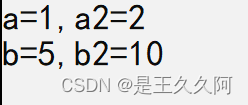
Found by test :
- The shift left operator can achieve *2 The effect of , The left one , The number *2; Move two places to the left , The number *4, And so on .
- The displacement operator does not change the original value , Instead, it creates a new value that can be used or assigned .
2. Shift right operator
The rules : The right shift operator is divided into two rules: logical shift and digital shift .
Logical displacement : Left complement 0, On the right, abandon .
Arithmetic displacement : The sign bit of the left complement value , On the right, abandon .
Arithmetic displacement can ensure that the new value has the same sign as the original value , More scientific than logical displacement , Most compilers adopt this rule .
for example :
int a = -5;
Original code :10000000 00000000 00000000 00000101
Inverse code :11111111 11111111 11111111 11111010 // The sign bits remain the same , Other bits are reversed
Complement code :11111111 11111111 11111111 11111011 // Inverse code +1 Get the complement
a >> 1:
Complement code :11111111 11111111 11111111 11111101 1 // The sign bit of the left complement value 1, On the right, abandon 1
Inverse code :10000000 00000000 00000000 00000010
Original code :10000000 00000000 00000000 00000011 //a>>1 = -3
#include<stdio.h>
int main()
{
int a = 1;
int a2 = a >> 1;
printf("a=%d,a2=%d\n", a, a2);
int b = -5;
int b2 = b >> 1;
printf("b=%d,b2=%d\n", b, b2);
return 0;
}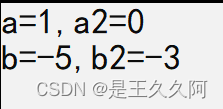
notes : For the displacement operator , Only moving positive integer digits is meaningful ! Move negative numbers 、 Decimals, etc. are undefined by the standard , Meaningless .
Displacement operator usage
1. Use the displacement operator to convert integers into binary form
#include<stdio.h>
#include<limits.h>
void itobs(int n, char* ps);// Compute binary
void print_bstr(const char* str);// Print binary
int main()
{
printf(" Please enter a number or Press any other key to exit \n");
int number = 0;
char bin_str[CHAR_BIT * sizeof(int) + 1]={0};
//CHAR_BIT Express char The number in , The return value is 8
//8 * sizeof(int) Is the number of digits in an integer , You also need to leave a place for the terminator , Again +1
while (scanf("%d", &number) == 1)// Jump out of the loop when entering illegal characters
{
itobs(number, bin_str);// Compute binary
printf("%d The binary sequence of is :>", number);
print_bstr(bin_str);// Print binary
putchar('\n');
}
return 0;
}
// Compute binary
void itobs(int n, char* ps)
{
int i = 0;
const static int size = CHAR_BIT * sizeof(int);
for (i = size - 1; i >= 0; i--, n >>= 1)
{
*(ps + i) = (01 & n) + '0';
// In order to fit the computer better , use 01&n,01 by 8 Hexadecimal sequence form ,1&n Yes ,
// Because the form of array is char type , In order to express 0 or 1, You also need to add characters 0 Value
}
*(ps + size) = '\0';// The last position is assigned with a terminator
}
// Print binary sequence
void print_bstr(const char* str)
{
int i = 0;
while (*(str + i))// It's not an empty character
{
putchar(*(str + i));
if (++i % 8 == 0)// For viewing purposes , Every time 8 One space
putchar(' ');
}
}- In the above code , CHAR_BIT It's a header file <limits.h> Macro definition in , This macro represents char The number in , The return value is 8.
- expression sizeof(int) Find the size of an integer , The result is 4 Bytes ; expression CHAR_BIT * sizeof(int) Represents the number of digits of an integer .
- function itobs Medium for The cycle starts from the last bit , Calculate the binary result , At the end of each cycle ,n>>1 Moves to the right one , Perform the previous calculation .
- Formula 01&n There are only two results :0 or 1, In order to carry on char The array of type shows 0、1, You also need to add characters to the calculation result 0 Size (‘0’).
- All operations in functions are in the form of pointers , So there is no need to return a value .
The final result is as follows :
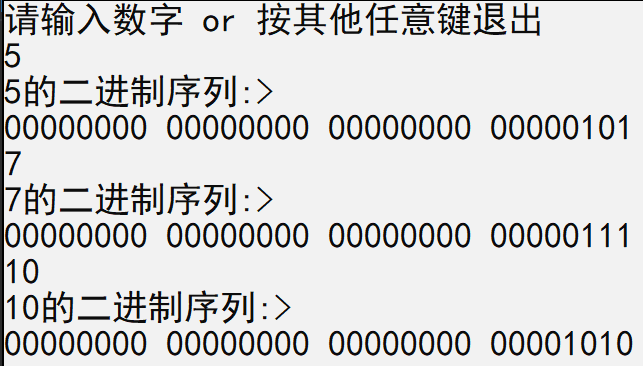
2. After converting a value n position
Bitwise negation operator can switch all bits of a value , But the selected special location cannot be switched . Suppose you want to switch the last four digits of a value , How to do it? ?
You can use bitwise XOR (^) Finish the task , First create a mask , Then set the last four bits of the mask to 1, XOR the value you want to change with the mask , You can switch the last four digits of the value .
int invert(int num, int bits)
{
int mask = 0;
int val = 1;
while (bits-- > 0)
{
mask |= val;
val <<= 1;
}
return num ^= mask;
}- In the above formula , use num Receive the value you want to change , use bits Receive the number of digits you want to change .
- mask For the mask ,val Set to 1, take mask And val Do or wait (|=), Can be mask The last digit is changed to 1, And then val One unit to the left , Cycle again , change mask The penultimate value , And so on , Until the end of the cycle .
- hypothesis bits=4, So jump out while After the cycle ,mask The value stored on the computer is 000011111( Last eight ), With the num To engage in exclusive or , You can switch num The last four values .
Put this function in the conversion binary example , The operation results are as follows :
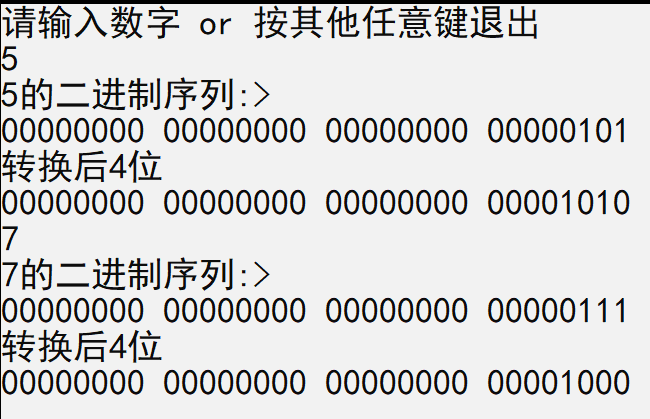
Through observation, we found that , The XOR operation reverses the values of the last four digits .
边栏推荐
- 162. Find peak - binary search
- Questions and answers of "Fundamentals of RF circuits" in the first semester of the 22nd academic year of Xi'an University of Electronic Science and technology
- JS interview questions (I)
- FileInputStream和BufferedInputStream的比较
- 阿里云微服务(一)服务注册中心Nacos以及REST Template和Feign Client
- View UI Plus 发布 1.2.0 版本,新增 Image、Skeleton、Typography组件
- Alibaba cloud microservices (II) distributed service configuration center and Nacos usage scenarios and implementation introduction
- Arduino+ds18b20 temperature sensor (buzzer alarm) +lcd1602 display (IIC drive)
- MYSQL索引钟B-TREE ,B+TREE ,HASH索引之间的区别和应用场景
- TYUT太原理工大学2022软工导论考试题型大纲
猜你喜欢
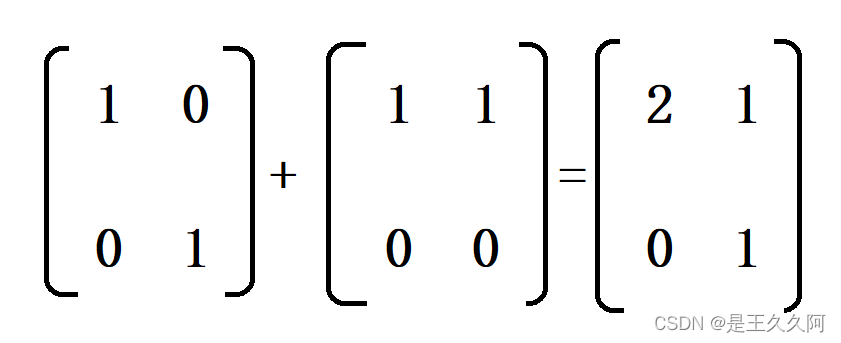
1.C语言矩阵加减法
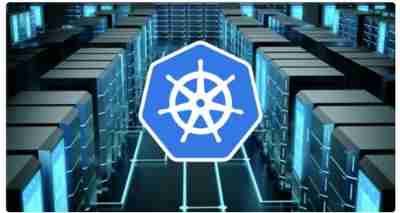
Cloud native trend in 2022

Quickly generate illustrations

TYUT太原理工大学2022数据库大题之分解关系模式
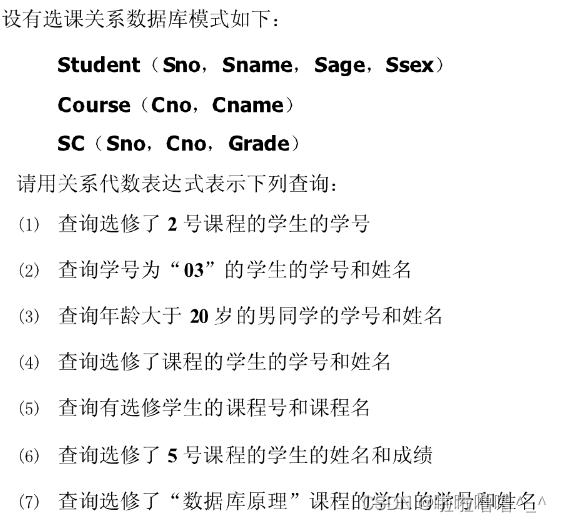
TYUT太原理工大学2022数据库之关系代数小题
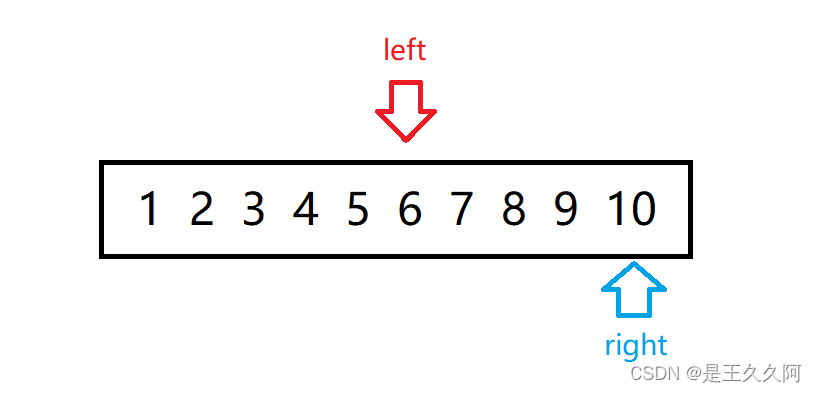
4.二分查找

View UI Plus 发布 1.2.0 版本,新增 Image、Skeleton、Typography组件

2-year experience summary, tell you how to do a good job in project management
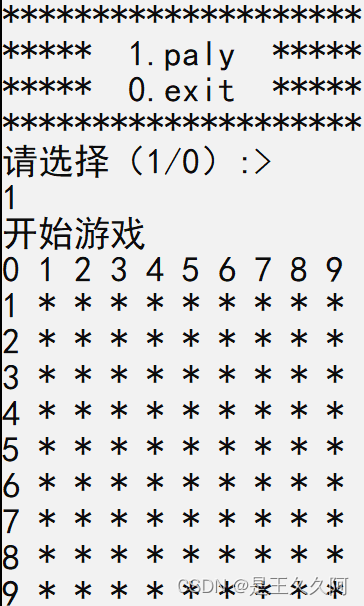
C language to achieve mine sweeping game (full version)
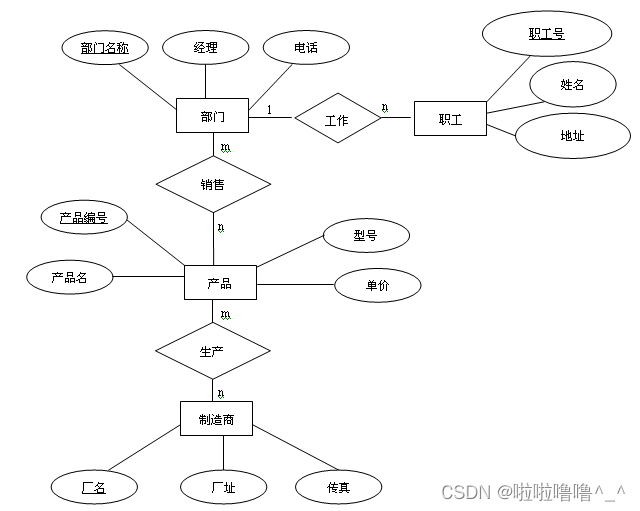
Conceptual model design of the 2022 database of tyut Taiyuan University of Technology
随机推荐
FileInputStream和BufferedInputStream的比较
20220211-CTF-MISC-006-pure_ Color (use of stegsolve tool) -007 Aesop_ Secret (AES decryption)
【快趁你舍友打游戏,来看道题吧】
系统设计学习(三)Design Amazon‘s sales rank by category feature
Floating point comparison, CMP, tabulation ideas
[中国近代史] 第九章测验
5. Download and use of MSDN
View UI Plus 发布 1.1.0 版本,支持 SSR、支持 Nuxt、增加 TS 声明文件
Questions and answers of "basic experiment" in the first semester of the 22nd academic year of Xi'an University of Electronic Science and technology
【毕业季·进击的技术er】再见了,我的学生时代
View UI plus releases version 1.1.0, supports SSR, supports nuxt, and adds TS declaration files
系统设计学习(二)Design a key-value cache to save the results of the most recent web server queries
阿里云微服务(三)Sentinel开源流控熔断降级组件
MYSQL索引钟B-TREE ,B+TREE ,HASH索引之间的区别和应用场景
继承和多态(下)
(超详细二)onenet数据可视化详解,如何用截取数据流绘图
4. Binary search
5. Function recursion exercise
TYUT太原理工大学2022“mao gai”必背
TYUT太原理工大学2022软工导论简答题